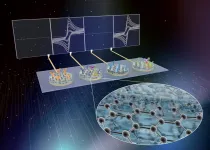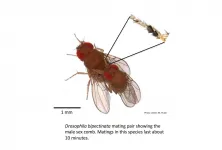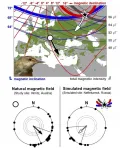(Press-News.org) In your quest for true love and that elusive happily ever after, are you waiting for the "right" person to come along, or do you find yourself going for the cutest guy or girl in the room, hoping things will work out? Do you leave your options open, hoping to "trade-up" at the next opportunity, or do you invest in your relationship with an eye on the cost-benefits analysis?
For something so fundamental to our existence, mate selection remains one of humanity's most enduring mysteries. It's been the topic of intense psychological research for decades, spawning myriad hypotheses of why we choose whom we choose.
"Mate choice is really complicated, especially in humans," said Dan Conroy-Beam(link is external), an assistant professor in the Department of Psychological and Brain Sciences at UC Santa Barbara, and author of a paper(link is external) in the journal Personality and Social Psychology Review. "And there have been a lot of people who have proposed abstract ideas about how it might happen."
One line of thinking, for instance, posits that we assess potential mates against an internal threshold of preferred qualities and attributes -- a "minimum bar," that they have to meet to be considered a potential partner.
"And we learn where that minimum bar is based on how other people treat us," he said. Another model describes the dating market somewhat like the European social dances of the 18th century.
"One side approaches the other side and they get these kinds of temporary relationships going," Conroy-Beam said. "And basically you stay in a relationship until you get a better offer and everybody kind of recurrently ditches their partners for better ones."
But these mate selection models, and others like them, don't capture a lot of the nuance that goes into real-life mate selection, Conroy-Beam noted.
"When you have a system that is particularly complicated like human mating markets are, verbal models are sometimes not such a great way to understand what's going on," he said. Competing desires and social dynamics play heavily into mate selection, he explained, adding layers of complexity and moving parts that can't be captured or quantified.
So what can hold human-like multiple levels of detail and complexity? The next best thing: a computer simulation. In an effort to move understanding of mate choice forward, Conroy-Beam has developed a new approach -- called "couple simulation" -- that essentially test-drives models of mate selection against the attributes and priorities of a sample of real-life couples.
"The real advantage that we have here is that we're going away from just these verbal models and into explicit computational models," he said. "We're directly simulating people's real choices; we're removing the limits of doing this in our own heads because we have computers that can keep track of all the very complicated interactions that are going on."
Sim Dating
The process begins by measuring the traits and preferences of a population of a few hundred couples -- real people who have made real-life mate choices. That data is crunched into simulated copies of each person -- "avatar agents" that have the same attributes and desires as their human counterparts, except in the simulated world they're single.
"We break them up and throw all these little agents into the market," said Conroy-Beam, who received support for his research from the National Science Foundation's Early CAREER program. "Then we run various algorithms and see which ones do the best job at putting them back together with the agent representing their real-world partner."
The algorithms represent different models of mate selection, which dictate the rules by which the agents can interact, based on the predictions of the model. In addition to the Aspiration Threshold Model (minimum bar) and the Gale-Shapley Algorithm (optimizing stable pairs), the team also used the Kalick-Hamilton Model (KHM), which assumes people choose mates according to their attractiveness, and a new model Conroy-Beam proposed called the Resource Allocation Model (RAM).
"It's thinking about mate choice in terms of investment of limited resources," he said. "So you've only got so much time and so much money and so much energy that you can dedicate to potential partners. And so your question as the person who's looking for a partner is 'who deserves most of these limited resources?'"
Conroy-Beam's model, it turns out, proved to be the most accurate, correctly matching approximately 45% of the couples in the simulated market in the very first runs of couple simulation. What makes the Resource Allocation Model work so well?
"There are a number of differences between RAM and the other models," he said. "The other models treat attraction like an on/off switch, but RAM allows for gradients of attraction. It also incorporates reciprocity: the more a potential mate pursues you, the more you pursue them in return," he said. The Gale-Shapley algorithm came in second, followed by the aspirational threshold model and then the KHM (attractiveness). Random pairings came in last.
It's still early days for couple simulation; after all, Conroy-Beam said, 45% right is still 55% wrong. For a first pass, however, 45% accuracy is impressive, and according to the study, the people in this cohort also report having higher-quality relationships (more satisfied, more committed, more love, less jealous) than the people in the inaccurately paired couples.
Conroy-Beam and his team at the Computational Mate Choice Lab at UCSB will continue to refine their models, which he calls "really rough sketches," to increase accuracy. They're hoping to soon conduct a longer term longitudinal study to see if couples that are accurately predicted differ in longevity.
"We hope to do this across cultures as well as to incorporate same-sex couples in the near future," he said. "We also have plans in the next couple of years to try to apply this to single people to prospectively predict their future relationships."
INFORMATION:
This research was supported by NSF Early CAREER award 1845586
CHICAGO (February 12, 2021): Since 2010, National Institutes of Health (NIH) funding to support surgeon scientists has, remarkably, risen significantly while funding to support other non-surgeon physicians has significantly decreased. This growth has occurred despite an overall decrease in NIH funding and an increase in demand for clinical productivity. These findings are according to an " END ...
Scientists at Lund University have discovered how E. coli bacteria target and degrade the well-known oncogene MYC, which is involved in many forms of cancer. The study is now published in Nature Biotechnology.
Cancer cells grow too fast, outcompete normal cells and spread to distant sites, where they cause metastases. Understanding what makes cancer cells so efficient and threatening is critically important and stopping them has always been the goal of cancer research. Early studies identified so-called ''oncogenes''; genes that that normally control cell growth but when mutated may be responsible for the creation of cancer cells and explain their competitive advantage.
The pleiotropic transcription factor MYC has been ...
(BOSTON) -- Many life-threatening medical conditions, such as sepsis, which is triggered by blood-borne pathogens, cannot be detected accurately and quickly enough to initiate the right course of treatment. In patients that have been infected by an unknown pathogen and progress to overt sepsis, every additional hour that an effective antibiotic cannot be administered significantly increases the mortality rate, so time is of utmost essence.
The challenge with rapidly diagnosing sepsis stems from the fact that measuring only one biomarker often does not allow a clear-cut diagnosis. Engineers have struggled for decades to simultaneously quantify multiple biomarkers in whole blood with high ...
The drug thalidomide was sold as a sedative under the trade name Contergan in the 1950s and 1960s. At the time, its side-effects triggered one of the largest pharmaceutical scandals in history: The medication was taken from the market after it became known that the use of Contergan during pregnancy had resulted in over 10,000 cases of severe birth defects.
Currently, the successor preparations lenalidomide and pomalidomide are prescribed under strict supervision by experienced oncologists - the active ingredients are a cornerstone of modern cancer therapies. The use of lenalidomide and pomalidomide has considerably improved the success ...
EL PASO, Texas - Science is a step closer to a new response to obesity, thanks in part to a study conducted by a team that included Sergio Iñiguez, Ph.D., associate professor of psychology at The University of Texas at El Paso.
The 10-member team led by Brandon Warren, Ph.D., assistant professor of pharmacodynamics at the University of Florida, made discoveries about a specific area of the brain tied to recollection and the desire to seek and consume food. It could lead to a way to inhibit the desire to overeat.
Iñiguez, who directs UTEP's Iñiguez Behavioral Neuroscience Lab and helped design novel experimental techniques for the research, said that people tend to overeat when exposed to cues or environments that remind them of treats, which is one reason ...
BUFFALO, N.Y. - Humpback and bowhead whales are the only mammals other than humans thought to progressively change the songs they sing through a process of cultural learning.
But maybe the humpbacks are no longer part of that trio. Humpbacks might be singing songs that are not as "cultured" as once assumed.
A new study by a University at Buffalo researcher is directly contradicting the widely accepted cultural transmission hypothesis suggesting that whales learn their songs from other whales.
"It seems like that is not correct," says Eduardo Mercado, a professor of psychology in UB's College of Arts and Sciences. "Our findings indicate that neither cultural transmission nor social learning contributes significantly to how humpback whales ...
Scientists have accepted natural selection as a driver of evolution for more than 160 years, thanks to Charles Darwin.
But University of Cincinnati biologist Michal Polak says Darwin's book "The Descent of Man" only tells part of the story. Sometimes when the victor vanquishes his sexual rival, the quest to pass genes to the next generation is just beginning.
According to a new UC study published in the journal Current Biology, male fruit flies with the most impressive sexual ornamentation also have super sperm that can outcompete that of rivals in the post-mating fertilization game.
UC studied Drosophila bipectinata, a tiny red-eyed fruit fly ...
Researchers of the Research Programme on Biomedical Informatics (GRIB) from UPF and Hospital del Mar Medical Research Institute (IMIM) in Barcelona, Spain, have identified behavioural and linguistic changes in tweets in Spanish published by users suffering from depression and who are taking medication to treat this disease.
Their work has been published in Journal of Medical Internet Research and was led by Ferran Sanz; with Angela Leis and Francesco Ronzano as first authors, who conducted the work together with Miguel Angel Mayer and Laura I Furlong, all from the Integrative Biomedical Informatics research ...
Fast and energy-efficient future data processing technologies are on the horizon after an international team of scientists successfully manipulated magnets at the atomic level.
Physicist Dr Rostislav Mikhaylovskiy from Lancaster University said: "With stalling efficiency trends of current technology, new scientific approaches are especially valuable. Our discovery of the atomically-driven ultrafast control of magnetism opens broad avenues for fast and energy-efficient future data processing technologies essential to keep up with our data hunger."
Magnetic materials are heavily used in modern life with applications ranging from fridge magnets to Google and Amazon's ...
Birdwatchers get very excited when a 'rare' migratory bird makes landfall having been blown off-course and flown beyond its normal range. But these are rare for a reason; most birds that have made the journey before are able to correct for large displacements and find their final destination.
Now, new research by an international team shows for the first time, how birds displaced in this way are able to navigate back to their migratory route and gives us an insight into how they accomplish this feat.
Writing in Current Biology, the team from Bangor and Keele Universities describe how reed warblers can navigate from a 'magnetic position' beyond what they have ...





